This meant that extra accommodation was needed at the
Kingston Road school, so three Horsa Huts were
installed to provide more classrooms. By 1946 there were over
550 pupils and there were plans to build a new school, though
this was not to happen for some time yet. However, three years
later,the playing field at Dilston Road was being fenced,
which was on land adjacent to the new school site. By 1952 the
school was so crowded that there were times when three classes
had to share one of the Horsa Huts and the situation was
becoming impossible.

However, by 1953 the new school was at long last ready for
occupation and Mr Stanley Moore (who had
been Head since 1938) and some of the teachers spent a great
deal of time making arrangements to move into the new
building. Unfortunately, it was not just a simple matter of
transferring the whole school from one building to another.
Owing to financial cuts by Government in education, the
building programme had been halved, which meant that the new
school was not big enough to take all the pupils, of whom
there were by then over 700. So they were divided between
Dilston Road for the older pupils and Kingston Road for the
younger ones and it was to be another twenty three years
before all the pupils could be housed in the Dilston Road
buildings.
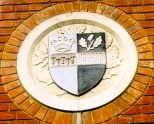
The old Surrey County Council
crest which is above the main entrance
Opening of the school at Dilston Road
As the two schools are over a mile apart, it must have been
extremely inconvenient for all concerned.However, in April
1953 some of the second year pupils and all of the third,
fourth and fifth year pupils moved into the newly completed
building which was opened officially later that year, on
24th November, by Lady Maxwell Fyfe.
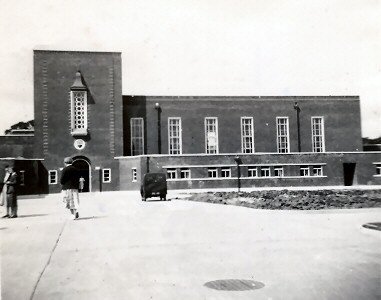
1953 - view at entrance from Dilston Road
source: Judith Crawford (néeTyrrell) 48-53 |
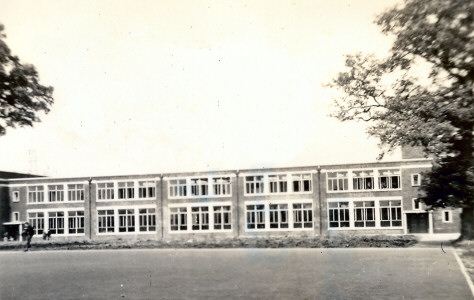
1953 - view from Cleeve Road
source: Crawford |
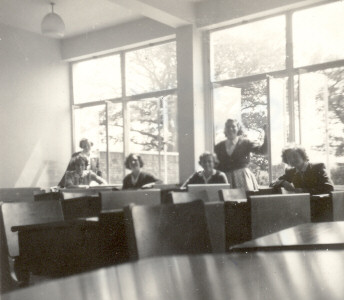
A classroom: L-R (standing): Julie Ford - Judith Tyrrell
L-R (sitting): Mavis Fisk - Elizabeth Clark - Gillian Manser
- Denise Wright
source: Crawford
When the new building first opened, it was treated with
such respect that no outdoor shoes were allowed to tread the
polished wood floors, especially the one in the Hall used
every day for Assembly! This hall was also used as a
gymnasium and Mr Moore refused to allow fixed apparatus to
be installed there, as he felt that this would further delay
the building of the proposed gymnasium which had been
promised.
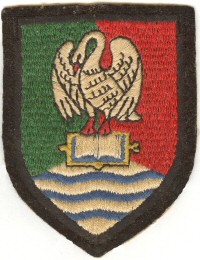
The original School Badge: source Crawford
Mr Claytor - a man of immense will-power
At the end of the summer term in 1957 Mr
Moore retired after eighteen years as Headmaster. In
September, he was succeeded by Mr Frank E Claytor
and within another two years there were over 1,000 children
attending the school. Mr Claytor was a man of immense
will-power and courage - he had one arm which was useless,
but so determined was he to overcome this handicap that
other people were hardly aware of it. He played every form
of sport and gave demonstrations of how to make equipment
for scientific experiments and would in no way allow his
disability to curtail his activities.

The buildings at Dilston Road get a name
It was he who decided that the school should have a name. In
February 1964 he received notification from the Divisional
Education Officer that the Governors' request for a name for
the school had been granted by the Surrey Education
Committee. From henceforth, the school was to be known by
its present name of Therfield School. Mr
Claytor had suggested this name to the School Governors
after having done some research to find a suitable name and
on 6th February 1964 he wrote in the School Log Book:
"This name is connected with the district in that we
stand on land which was once part of the Manor of
Pachesam, and this Manor was presented to Brian de
Therfield by King John in 1205."
Mr Claytor remained in charge of the school until 1972, two
years before his death.
Mr John D Wooding, Head 1972-85,
recalled many happy memories of staff and pupils. On arrival
he was faced with a school in three locations (some were on
the site of the United Dairies depot, as well as at Dilston
Road and Woodvill/Kingston Road): school leaving age was
rising to 16, the school was to go fully comprehensive and
was to be concentrated on one site. There was a strong
'family' atmosphere which he wished to preserve as the
school enlarged. In April 2002 he provided the following:
EVENTFUL YEARS - 1972 to 1985
Most of the events described were not discrete happenings;
they inevitably reacted with others to make life more
complicated, Many changes were required by Government and/or
Surrey County Council; others were made by Therfield to meet
the school's special needs.
ROSLA (The acronym for the raising of the school
leaving age to 16)
There was a national apprehension that requiring reluctant
15 year olds to stay on for another year would be fruitless
and disruptive. There was no set curriculum; It was largely
left to schools and their teachers to provide stimulating
and worthwhile courses. Amazingly, there were few problems.
In fact, many pupils gained exam passes, and some wanted to
continue with further studies as they realised their own
capabilities.
COMING TOGETHER (under one roof)
Therfield's upper school (13 plus) was housed at the main
Dilston Road site.
The lower school was in older buildings in the Kingston
Road, some 20 minutes walk away.
A few classes were held in rooms rented in the nearby United
Dairies building. I was concerned that there was only
limited day-to-day contact between the upper and lower
sections, and so the coming together required careful
planning. To meet the immediate and progressive needs there
had to be successive building programmes at Dilston Road.
The lower school site was taken over by Woodville School.
Our own two groups of teachers merged with alacrity.
SURREY CHANGES ITS PATTERN OF SCHOOLS
Surrey LEA decided to reorganize all its schools with new
age ranges. It created First & Middle schools and moved
secondary transfer from age 11 to age 12. Therfield worked
closely with its linked middle schools to ensure that the
curriculum flow was harmonious. On the whole the new system
worked well but there were two intractable problems. The
middle schools had difficulty in recruiting specialist
teachers (especially Science, Crafts and French) for their
top year. Also, with most LEAs keeping 11+ transfer,
problems could arise when families moved in or out of
Surrey.
GOING COMPREHENSIVE
This was the most challenging task for Surrey's secondary
schools. As a former grammar school teacher I had come to
consider that the 11+ was unreliable and unfair; it wasted a
great deal of our national talent. At Therfield, we did not
accept the rush into mixed ability classes. We looked for a
system which provided flexibility and individual
opportunity. There were broad ability bands which allowed
for movement, and some subject setting within the bands. The
control lattice featured horizontal year groups and vertical
house groups. Even so, it took years of striving and shaping
before we felt that we were providing a fair deal for the
range of abilities.
INTERNAL DEVELOPMENTS
CAREERS
We opened a Careers/Counselling dept which included an
annual fair to link employers, students and parents. There
was an Information Centre, an interview scheme, and some
aptitude testing. There was work experience available for
all Fifth formers. The head of careers had help from most of
her colleagues in supervising this programme.
SPECIAL NEEDS
A classroom was allocated and fitted out for those needing
urgent remedial teaching in small groups. The purpose was to
return pupils to their normal classes as soon as a
significant improvement was made. I often joined the teacher
to encourage and help with the reading.
We were also concerned that exceptionally gifted pupils of
all ages should meet together (out of school lesson time)
with a gifted Cambridge graduate to stimulate lively
discussions and problem solving. The BBC became interested,
and the group was televised in competition with a similar
group of Moscow students.
CARE COMMITTEE
This was set up to meet twice termly for the early detection
and treatment of student problems referred by teachers.
These might include such difficulties as learning, health
and inter-personal relationships. The school doctor, welfare
officer, psychologist and social worker joined with the year
heads. We found that the most appropriate professional
skills were enlisted with minimum delay.
SIXTH FORM
The small existing sixth form expanded rapidly and a full
range of courses was soon available. Some courses with
limited demand such as Economics and Business Studies were
set up as joint projects with other local sixth forms. Our
Sixth formers provided excellent leadership in the main
school and they helped the staff run the other year groups
parents evenings.
PERSONAL DEVELOPMENT
What could we do to increase self confidence and strengthen
relationships between pupils, their peer groups and their
teachers? We squeezed some school time for an experimental
course for study skills (homework, note-taking revision
etc.) and teaching some social graces.
DEPARTMENTAL PROJECTS
Music and Drama: A staff team produced a succession of the
popular musical shows: Oliver, Grease, Fiddler on the
Roof, The Boy Friend. The Swing Band was started.
The Technical Dept built a hovercraft which floated over our
playing fields.
The new Leatherhead Leisure Centre enabled us to teach
swimming, and some time later the Therfield Sailing Club was
an instant success.
The advent of personal computers proved a boon to all
departments and, in particular, changed the character of our
secretarial courses
PARENTS
Vital to our progress through the years was the
trust and support of our parent body, not only in
fund-raising but in their continual encouragement for us to
implement new ideas. When the Year Heads all reported that
parental attendance at the year progress evenings had risen
sharply to exceed 90%, we knew our parents had become both
friends and partners in the education of their children.
THE SCHOOL STAFF
Our teaching staff were exceptionally able and hard working
professionals.They never worked in isolation but were always
helping and encouraging one another. Many devoted countless
hours after school and during vacations with clubs outings
and productions.
Their combined skills raised the Ordinary Level pass rate by
400% over about 10 years. We lost many fine teachers to
headships and deputy headships elsewhere, but there was
always younger talent eager to replace them. The teachers in
turn were supported by technicians and other ancillary
staff.
A focal point for most schools is the office. Supervised by
a highly competent secretary, the office staff were
industrious,diplomatic and protective. On behalf of the
school I thank all of the staff who helped over this busy
period.
Finally, these eventful years at Therfield seemed to pass
all too quickly. There were many occasions with stresses and
heartaches but, for most of us, we cherish the memories of
laughter, pride and friendship from our life together.
***

Mr Frank E
Claytor
Headmaster
1957-72 d1974 |

Mr John D
Wooding
Headmaster
1972-85 d2011 |

Mr Terry R
Reddin
Head Teacher
Jan 1986-2001 |

Mr Graham
Tuck
Headteacher
Sep 01-Dec 06 |

Mrs Susan
Willman
Headteacher
Jan 07-14
prev Dep Head
|
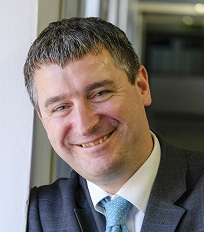
Mr James
Malley
Headteacher
Jan 15 - |
This history will be brought up to date in due course.
Anyone who has pictures we could use to illustrate this page
should please contact Frank Haslam, the editor of this page,
on therfieldalumni@leatherheadweb.org.uk
Links
Leatherhead
& District Local History Society
Highlights
of
the 1968 Therfield Magazine
Extracts
from the 1974 Therfield Magazine
Therfield
Journal 1985
www.leatherheadweb.org.uk/therfieldalumni
 Our History from 1945
Our History from 1945 Our History from 1945
Our History from 1945